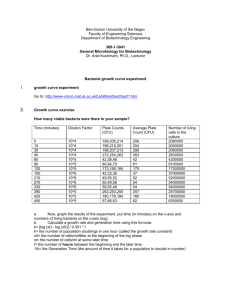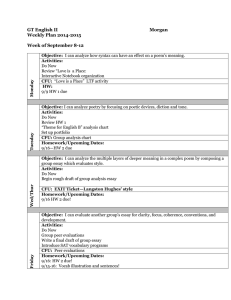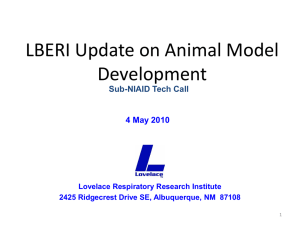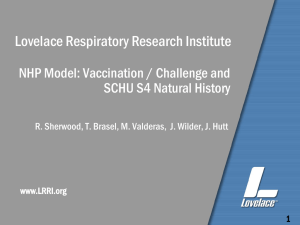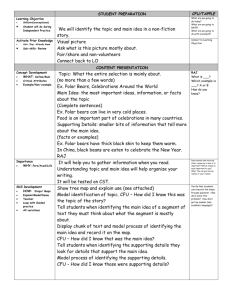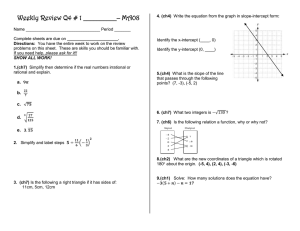Tularemia Vaccine Development Contract Progress in Tularemia Bioaerosol Characterization and Non-Human Primate
advertisement
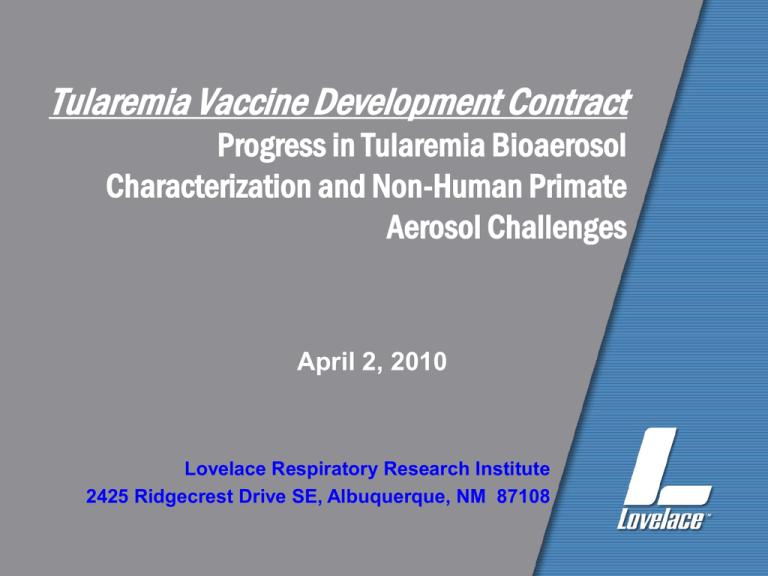
Tularemia Vaccine Development Contract Progress in Tularemia Bioaerosol Characterization and Non-Human Primate Aerosol Challenges April 2, 2010 Lovelace Respiratory Research Institute 2425 Ridgecrest Drive SE, Albuquerque, NM 87108 AGENDA 10:00 – 10:15 Scientific Overview C. Rick Lyons 10:15 – 10:30 Update: Goals & Milestones Achieved R. Sherwood 10:30 – 11:30 NHP Model Development (MS 8, 9, 10, 11) R. Sherwood, J. Wilder, T. Brasel 11:30 – 12:00 Lunch Break 12:00 – 1:00 NHP Model Development (MS 12-15, 1722, 29) J. Wilder 1:00 - 1:45 J. Hutt 1:45 – 1:55 NHP Histopathology with SchuS4 Infection Afternoon Break 1:55 – 2:15 LBERI Problems Encountered R. Sherwood 2 7296-2 AGENDA (Cont.) 2:15-2:30 Milestone Completion Reports R. Sherwood 2:30 – 3:00 Publications R. Sherwood 3:00 – 3:15 2010 Annual Meeting Rick Lyons/ Barbara Griffith 9:15 – 9:45 Administrative Discussion B. Griffith 3 7296-3 Scientific Overview C. Rick Lyons, UNM 4 7296-4 Update: Goals & Milestones Achieved R. Sherwood, LBERI 5 7296-5 Goals & Milestones Achieved Milestones completed – MS#3, MS#4, MS#7, MS#11 Goals completed – Determined aerosol LD50 in cynos – Determined aerosol natural history for cynos at target dose of 1000 CFU – Determined that LVS vaccination can protect Cynos against aerosol tularemia challenge 6 7296-6 Remaining Challenges Determine optimal LVS vaccination procedure so that LVS can be used as a positive control in future vaccine studies Determine if any currently used immune parameters may be useful in predicting immune status and infectious challenge outcome 7 7296-7 Future Plans Perform broth comparison challenge study to clarify if LVS growth conditions might alter vaccine survival Complete study of tularemia infection in vaccinated animals Complete study of vaccine duration Perform one NHP vaccine efficacy study 8 7296-8 NHP Model Development (MS 8,9,10,11) R. Sherwood, T. Brasel, LBERI 9 7296-9 NHP Study Plans Broth Comparison Study Effect of LVS Vaccination on SCHU S4 Pathogenesis – Telemetered and non-Telemetered arms LVS Vaccine Duration Tularemia Vaccine Efficacy (Optional) 10 7296-10 Broth Comparison Study Goal – Determine if infection with SCHU S4 grown in Chamberlain’s broth affects virulence in Cynos as compared to growth in Mueller Hinton Broth II 11 7296-11 Broth Comparison Study Experimental Design Test Group Number Pathogen Challenge -Study Day (Challenge Dose) Group Designation Animals/ Group Vaccine Dose (cfu/Animal) Vaccination Study Day 1 Control (unvaccinated) 3 NA NA 35 (~ 1000 cfu, CB) 2 Control (unvaccinated) 3 NA NA 35 (~1000 cfu, CAMHB) 3 DVC LVS Lot 17 7 1.8x108 cfu 0 35 (~1000 cfu, CB) 4 DVC LVS Lot 17 7 1.8x108 cfu 0 35 (~1000 cfu, CAMHB) 12 7296-12 Broth Comparison Study Timeline – In life -5/11 – 6/15 – Path Report - 8/31/10 – MS Report - 9/20/10 13 7296-13 Effect of LVS Vaccination on SCHU S4 Pathogenesis Goal – Determine how LVS vaccination with Lot 17 affects SCHU S4 pathogenesis in telemetered and non-telemetered Cynos 14 7296-14 Effect of LVS Vaccination on SCHU S4 Pathogenesis Experimental Design Test Group Number Group Animals/ Group Vaccine Dose Vaccination (cfu/Animal) - Study Day 1 DVC LVS Lot 17 12 1.8x108 cfu 0 2 DVC LVS Lot 17 24 1.8x108 cfu 0 Pathogen Challenge -Study Day (Challenge Dose) Sac Day 35 (~1000 cfu) Moribund 35 (~1000 cfu, CAMHB) 1, 2, 4, 6 15 7296-15 Effect of LVS Vaccination on SCHU S4 Pathogenesis Timeline – In life -July/Aug 2010 – Path Report - 11/15/2010 – MS Report - 12/5/2010 16 7296-16 LVS Vaccine Duration Goal – Determine the ability of Lot 17 LVS to protect Cynos against SCHU S4 aerosol challenge over a time period of up to 6 months – (already have short term duration data) 17 7296-17 LVS Vaccine Duration Experimental Design Test Group Number Group Animals/ Group Vaccine Dose (cfu/Animal) Vaccination Study Day Pathogen Challenge Study Day (Challenge Dose) 1 Control 8 -- 0 90, 180 (~1000 cfu) 2 DVC LVS Lot 17 16 1.8x108 cfu 0 90, 180 (~1000 cfu) 18 7296-18 LVS Vaccine Duration Timeline – In life -Fall 2010 – Spring 2011 – Path Report - 12 weeks post in-life – MS Report - 14 week post in-life 19 7296-19 Tularemia Vaccine Efficacy (Optional) Goal – Determine the ability of a tularemia vaccine to protect Cynos against an aerosol challenge with SCHU S4 20 7296-20 Tularemia Vaccine Efficacy (Optional) Experimental Design Test Group Number Group Animals/ Group Vaccine Dose (cfu/Animal) Vaccination Study Day Pathogen Challenge Study Day (Challenge Dose) 1 Control 6 -- 0 35 (~1000 cfu) 2 DVC LVS Lot 17 10 1.8x108 cfu 0 35 (~1000 cfu) 3 Test Vaccine 10 High Dose 0 35 (~1000 cfu) 4 Test Vaccine 10 Low Dose 0 35 (~1000 cfu) 21 7296-21 Tularemia Vaccine Efficacy (Optional) Timeline – In-Life - Spring 2011 – Path Report - 12 weeks post in-life – MS Report - 14 week post in-life 22 7296-22 MS #8 and MS #11 Results 7296-23 Milestone 8: Goal Determine the nature of LVS-vaccination in NHPs and its role in protection from SCHU S4 aerosol challenge 24 7296-24 Milestone 8: Objectives and Endpoints Describe the character of aerosol delivered SCHU S4 infection in NHPs that have been previously vaccinated with LVS –Compare two different methods of vaccination (scarification and subcutaneous) TUL08 A and B –Compare 4 different LVS lots as vaccines (all delivered by subcutaneous route) TUL08 C - Compare SCHU S4 growth media to see if it has an effect on virulence (Chamberlain’s broth vs. Mueller-Hinton broth) –TUL08 D - Examine the disease process in animals vaccinated with DVC Lot 17 post aerosol challenge with a lethal dose of SCHU S4 (1000 cfu) – Tul08E Endpoints – histopathology, bacteremia, bacterial CFUs of organs (lung, spleen, liver, kidneys, and lymph nodes), clinical signs, clinical chemistry, hematology, cytokine analysis (some studies, but not all) 25 7296-25 Milestone 8: Progress – Summary of TUL08 A - C LVS (DVC Lot 16, 17, 20, and USAMMDA Lot 4) given by sub-cutaneous inoculation (on back (TUL08 A and B; or stomach TUL08 C) – Range of inoculum: 7 x 105 – 9 x 107 CFU LVS – Humoral and cellular immunity measured weekly until challenge SCHU S4, grown in Chamberlain’s broth, delivered by head-only aerosol exposure on a day 35 - 51 days post-vaccination – Target dose of 1000 CFU presented in 3.5 L (range = 500 – 2872) Euthanize any survivors 21 days after exposure. Measure clinical signs daily; measure bacteremia on the day of aerosol challenge and 2, 4, 6, 10, 14 and 21 days post- SCHU S4 exposure; measure tissue burden of SCHU S4 at necropsy. 26 7296-26 Milestone 8: Progress – LVS Vaccination Induces Humoral Immunity in NHPs Units/ml determined by comparison to a positive control pooled plasma sample used as a standard curve in the LVS ELISA 27 7296-27 Milestone 8: Progress – LVS Vaccination Induces Cellular Immunity in NHPs as Evidenced by IFNγ Production by PBMCs 28 7296-28 Milestone 8: Progress – LVS Vaccinated NHPs are not Uniformly Protected from Death due to SCHU S4 Aerosol Challenge By ANOVA, all vaccinated groups were significantly different from the unvaccinated group, however there was no difference in survival between lots. 29 7296-29 Milestone 8: Progress – High Levels of IgG anti-LVS do not Predict Protection from Death due to SCHU S4 Aerosol Exposure Lot 16 Lot 17 Lot 20 Lot 4 None 40000 35000 30000 25000 20000 15000 10000 5000 0 -5000 100 150 200 250 300 350 Hours to Death 400 450 500 30 7296-30 Milestone 8: Progress – LVS Vaccination Leads to Reduced SCHU S4 Burden in Organs other than the Lung One Way ANOVA indicates there is no statistically significant difference in lung burden, however with respect to the TBLN, all vaccine lots are signifcantly different than the naïve controls 31 7296-31 Milestone 8: Progress – LVS Vaccination Leads to Reduced SCHU S4 Burden in Organs other than the Lung One way ANOVA indicates that in the spleen, bacterial burden in the vaccinees was significantly decreased as compared to the controls. This is true of the liver also, with the exception of Lot 16. 32 7296-32 Milestone 8: Progress – LVS Vaccination Leads to Reduced SCHU S4 Bacteremia as Compared with Control NHP Group/ Vaccine Lot Bacteremic NHP (During study) % Positive Bacteremia Control 3 of 3 100 Lot 16 0 of 3 0 Lot 17 1 of 3 33 Lot 20 2 of 8 25 Lot 4 2 of 8 25 33 7296-33 Milestone 8: Progress - Summary LVS vaccination of NHPs leads to: – Increased survival after SCHU S4 aerosol challenge – Increased humoral and cellular immunity; although neither high levels of antibody nor IFNγ production predict protection from SCHU S4 aerosol challenge – Decreased SCHU S4 organ burden in tissues other than the lung (blood, spleen, liver, lymph nodes); this is accompanied by decreased histopathology in spleen and liver LVS vaccination does not prevent clinical signs of illness 34 7296-34 Milestone 8: Remaining Challenges Thus far, LVS vaccination of NHPs provides only partial protection from SCHU S4 aerosol challenge – Hypothesize that growth of SCHU S4 in Chamberlain’s broth as compared to Mueller-Hinton broth may be allowing organism to stimulate very little innate immunity and thus grow to large numbers in the lung and eventually disseminate to peripheral organs where it leads to mortality – Growth in Mueller-Hinton broth has been shown to stimulate more inflammatory cytokine secretion by macrophages in vitro and may do so in the lung as well, leading to better control of growth and perhaps better overall protection from morbidity – This hypothesis will be directly tested in TUL 08 D 35 7296-35 Milestone 11: Goal Describe the natural history of aerosol delivered SCHU S4 in the cynomolgus monkey. 36 7296-36 Milestone 11: Objectives and Endpoints The primary objective of this study was to determine the natural course of disease in cynomolgus macaques of Vietnamese origin (with and without telemetry devices) that had been aerosol challenged with a dose of F. tularensis SCHU S4 that resulted in primary pulmonic disease. A secondary objective was to relate study results to human disease to the extent possible. Endpoints = histopathology, bacteremia, bacterial CFUs of organs (lung, spleen, liver, kidneys, and lymph nodes), clinical signs, clinical chemistry, hematology, cytokine analysis 37 7296-37 Milestone 11: Progress Study is completed. Report has been submitted to NIAID and includes the following as described in the SOW: – Histopathology and bacterial CFUs of internal organs (lung, spleen, liver, brain, and lymph nodes) – Record of clinical symptoms – Clinical chemistry and hematology during infection Data, protocols, and SOPs and documentation exist to generate a GLP compatible aerosol model of F. tularensis SCHU S4 38 7296-38 MS11 – overview of study design Test Group Number Group Designation 1 Sac 1 2 Sac 2 3 Sac 3 4 Sac 4 5 Sac 5 Animals/ Group 2 males/ 2 females 2 males/ 2 females 2 males/ 2 females 2 males/ 2 females 6 males/ 6 females Pathogen Challenge Study Day (Challenge Dose) Terminal Sacrifice – Study Day 0 (~ 1000 CFU) 2 0 (~ 1000 CFU) 4 0 (~ 1000 CFU) 5 0 (~ 1000 CFU) 6 0 (~ 1000 CFU) Terminal 39 7296-39 MS11 – Overview of Findings 40 7296-40 MS11 – Overview of Findings Sustained fevers were not detected in individual animals without telemetry; however, in animals with telemeters, prolonged fevers were detected. Hypothermia was a common finding prior to death with or without telemeters. 41 7296-41 MS11 – Overview of Findings Increases in respiration rate (~50 respirations per minute) were routinely observed in animals without telemetry; however, only a minor increase in respiratory rate was observed with telemeters. We hypothesize that the observed difference between manual respiratory rates could be due to telemeter lead placement. 42 7296-42 MS11 – Overview of Findings High levels of bacteria were found in the lung, TBLN, and spleen. Lower and more variable numbers of bacteria were found in the liver, MLN, and brain stem. In general, progressively higher numbers of SCHU S4 were recovered from organs with increasing time. Appearance in the spleen, liver, brain, and lymph nodes corresponded with bacteremia 43 7296-43 MS11 – Overview of Findings Hematology showed leukocytosis beginning days 2 to 3 and leukopenia days 5 and 6. Elevated CRP levels were typically observed on day 2 or 3 and appeared to correlate with dissemination from lungs. 44 7296-44 Milestone 11: Remaining Challenges and Future Plans There are no challenges for this milestone Future plans include addressing any comments on the final report and finalizing the report. 45 7296-45 Lunch Break 46 7296-46 NHP Model Development (MS 12-15, 17-22, 29) J. Wilder, LBERI 47 7296-47 Milestone 12/13: Goal Establish assays that detect the immune response to F. tularensis and vaccines designed to protect from disease induced by F. tularensis in multiple animal models – LBERI is tasked with developing immunoassays that detect the immune response in (LVS) vaccinated and SCHU S4 exposed NHPs 48 7296-48 Milestone 12/13: Goal – Progress toward Objective Develop immunoassays that reliably distinguish LVS-vaccinated from non-vaccinated NHPs –Thus far can rely on IgG anti-LVS ELISA for this purpose •Develop immunoassays that may distinguish NHPs which survive SCHU S4 aerosol challenge from those that do not –Thus far have not been able to refine our assays to function as such –IgG anti-LVS plasma levels do not correlate with protection –IFNγ production or proliferation by bulk PBMCs in response to LVS or SCHU S4 antigens also appear not to distinguish those NHPs which have been protected from SCHU S4-induced mortality but more data mining may be in order (i.e. only examining responsiveness early post-LVS vaccination or late; only looking at specific types of stimuli (FF vs. HK)) 49 7296-49 Milestone 12/13: Progress Microagglutination assay: – Designed to test LVS-specific agglutinating antibody in plasma or sera; likely IgM – As this assay was used in human clinical trials of vaccinees, it can be used to bridge the NHP data to the human data – Assay is working and the titer of the positive rabbit serum (courtesy of Dr. Marcelo Sztein, U. of Maryland) was determined to be 1: 2560 – The optimal antigen dilution (fixed hematoxylin-stained LVS) for use in the assay is between 1:4 and 1:8 – Day 7 plasma samples from NHPs are currently beeing analyzed at both antigen dilutions, 1:4 and 1:8 50 7296-50 Milestone 12/13: Progress (continued) - Performance of Formalin-fixed F. tularensis antigens in the IgG ELISA 51 7296-51 Milestone 12/13: Progress (continued) - Performance of Formalin-fixed F. tularensis antigens in the IgG ELISA Data interpretation: – DVC WT LVS (and SCHU S4) appear to work well in the IgG antiLVS ELISA whereas the mutant (minus LPS) mutants do not – It is unclear as to whether our ELISA detects antibodies directed to the LPS moeity of LVS or whether the mutant antigens fail to bind to the ELISA plate Recent acquisition of monoclonal antibodies specific for non-LPS moeities on LVS may help distinguish these two possibilities 52 7296-52 Milestone 12/13: Progress (continued) Protein Assay: – We would like to establish the F. tularensis CFU:protein ratio in live, formalin fixed (FF) and heat-killed (HK) preparations – Establishment of this ratio will allow us to normalize antigen preparations used to simulate NHP PBMCs in the ELISPOT and proliferation assays, as well as those used as coating antigens in the IgG anti-LVS assay – Fermentas Bradford Reagent has been purchased and sample buffer prepared according to description from Dr Anders Sjostedt, Umea University, Sweden We will soon test the FF and HK antigens from both UNM and DVC 53 7296-53 Milestone 12/13: Remaining Challenges No assay thus far can distinguish LVS-vaccinated NHPs that are protected from SCHU S4 aerosol exposure from those that succumb DVC FF LVS and SCHU S4 antigens are not performing as expected; they do not stimulate IFNγ production on a CFU/ml basis as well as FF antigens prepared by Dr. Lyons’ laboratory personnel at UNM 54 7296-54 Milestone 12/13: Future Plans Establish the protein content:CFU ratio of the FF and HK antigens in order to determine whether actual differences exist in their stimulatory capacity or differences exist in the amount of protein being used in the assays Test the ability of the microagglutination assay to detect NHP anti-LVS antibody Continue to explore both new assays (such as total cytokine secretion in addition of IFNγ ELISPOT) and different ways of expressing the cellular immunoassay data to determine whether NHPs protected from SCHU S4 aerosol challenge can be distinguished from those that succumb 55 7296-55 Milestone 21: Goal Establish assays of effector function that predict correlates of protection from SCHU S4 aerosol challenge – LBERI is tasked with developing immunoassays that distinguish NHPs that are protected from SCHU S4 aerosol challenge and those that succumb to it 56 7296-56 Milestone 21: Goal – Progress toward Objective Develop immunoassays of effector function that can detect correlates of protection from SCHU S4 aerosol-induced morbidity –Developing two assays for this purpose thus far: 1) Intracellular cytokine staining Perhaps IFNγ production by particular cell types will distinguish NHPs which are protected vs. those that are not Perhaps the presence of particular cells that are producing more than one cytokine (ex. IFNγ, TNFαand IL-2) will predict protection 2) inhibition of in vitro growth of SCHU S4 by some cells contained in the PBMC preparations of protected NHPs vs. those that succumb to SCHU S4 aerosol 57 7296-57 Milestone 21: Progress - Intracellular Cytokine Staining Several experiments have been conducted to stain CD3, CD4, CD8 (T cells) and IFN-g, TNF-a, IL-2 to look for multifunctional T cells in PBMC at different time points post vaccination and with different times for restimulation (6h, 12h, 24 h, 72 h) – HiCK-1 cell controls showed that the cytokine antibodies and staining protocol were working ELISpot assay for IFN-g secretion showed that PBMCs from vaccinated NHPs produced IFN-g above media background after 20 h of restimulation Using the 20 h of restimulation with hk or ff LVS investigated what PBMC subset produced IFN-g; NK-cells? NK-T cells? Monocytes/macrophages? 58 7296-58 Milestone 21 Progress: Intracellular Cytokine Staining - identifying NK cells in NHPs Human natural killer (NK) cells are often identified in PBMC as CD3CD16+CD56+, with CD56 being the most lineage specific marker Carter at al (Cytometry 37:41-50, -99) showed that CD56 identifies monocytes and not natural killer cells in rhesus macaques New staining panel : CD3/CD4/CD8 for T cells, CD16 for NK-cells and CD56 for monocytes/macrophages; IFN-g as the only cytokine; FcR block with anti-CD32 (FcgRII) Following slide shows frozen and thawed PBMC from NHP A07610, day 6 post LVS vaccination (106 LVS S.C); showed IFN-g response in ELIspot 59 7296-59 Milestone 21: Progress - IFN-g production PBMC from A07610 day 6 post LVS 70 % IFN-g+ PBMC, ffLVS 20 h %IFNg+ of CD3+CD4+ %IFNg+ of CD3+CD8+ %IFNg+ of CD3-CD16+ % IFNg+ of CD56+ 60 50 40 30 20 10 0 hkLVS per well with 4x10^5 PBMC % IFN-g+ of parent population % IFN-g+ of parent population % IFN-g+ PBMC, hkLVS 20 h 80 70 60 %IFNg+ of CD3+CD4+ 50 40 %IFNg+ of CD3+CD8+ 30 %IFNg+ of CD3CD16+ 20 10 %IFNg+ of CD56+ 0 0.00E+00 1.25E+04 5.00E+04 2.00E+05 ffLVS per well with 4x10^5 PBMC •Similar pattern when median fluorescence intensity is graphed instead of % IFN-g+ •CD56+ cells are the only population showing antigen dose dependent IFN-g production • High spontaneous IFN-g production by CD56+ cells 60 7296-60 Milestone 21: Progress - Intracellular cytokine staining – CD56+ cell production of IFNγ What more can be determined about the phenotype of the CD56+ IFN-g producers? How reproducible is the finding (i.e. can they be found in other LVS-vaccinated NHPs)? Next experiment: New animal with a positive LVS-stimulated response and low media background in IFN-g ELISpot. A07566 day 7 post s.c 107 LVS Stimulate 20 h with increasing concentrations of hk or ff LVS Stain surface: CD3, CD8 for T cells, CD14 for monocytes/macrophages, CD16 for NK-cells, CD56 (monocytes?) and IFN-g. 61 7296-61 Milestone 21: Progress - IFN-g production as measured by ICS from PBMC A07566 day 7 post LVS % IFN-g+ PBMC, ffLVS stimulated 20 h 60 50 40 30 20 10 0 -10 100.0 CD3+CD8CD3+CD8+ CD3-CD16+ CD56+ CD14+ hkLVS per well with 4x10^5 PBMC % IFN-g+ of parent population % IFN-g+ of parent population % IFN-g+ PBMC, hkLVS stimulated 20 h 80.0 60.0 CD3+CD8CD3+CD8+ 40.0 CD3-CD16+ CD56+ 20.0 CD14+ 0.0 0.00E+00 1.25E+04 5.00E+04 2.00E+05 -20.0 ffLVS per well with 4x10^5 PBMC •Similar pattern when median fluorescence intensity is graphed instead of % IFN-g+ •CD56+ cells are the cells that have the highest reponse to the antigen in a dose-dependent manner when measuring IFN-g day 7 post LVS 62 7296-62 Milestone 21: Progress - Cell surface phenotype of CD56+IFN-g+ PBMC CD8 SSC CD8 SSC CD3 FSC CD14 CD16 FSC A06944 CD14 CD3 FSC FSC 29976 CD16 CD8 SSC A07566 CD3 CD14 63 7296-63 Milestone 21: Progress - CD56 Human – other names: Leu-19, NKH-1, NCAM Ligands: NCAM-1, heparin sulfate MW 140kDa Cellular expression: T cells, NK-cells Mice – other names: NCAM MW 120, 140,180 kDa Ig superfamily Ligands; NCAM, heparin sulfate Cellular expression: NK, T (sub), neural tissue Function: adhesion, differentiation/development 64 7296-64 Milestone 21: Progress – Fresh (non-frozen) PBMC from A06944 day 14 post LVS 1.25x104 cfu 5x104 cfu 0 cfu 1.5% MFI 126 9.5 138 1.3 126 10.5 0.4 103 10.4 91 4.4 Day 14 post LVS Good T cell response to ff LVS but not hkLVS CD3+CD8+ CD8 T cells 122 3.3 116 CD3+CD8CD4 T cells 145 3.8 3.8 102 156 153 96 12.0 9.6 3.8 0.4 102 8.3 131 144 2x105 cfu 3.3 111 Lower media background in T cells compared to CD56+ cells 65 7296-65 Milestone 21: Progress – Fresh (non-frozen) PBMC from A06944 day 14 post LVS – CD56+ cells Gated CD56+ cells 0 cfu 1.25x104 cfu 5x104 cfu 2x105 cfu % IFN-g+ A06944 PBMC 20h ffLVS, fresh PBMC 59.5 1399 57.3 1204 % IFN-g+ of legend populations 1270 58.5 1332 1482 62.3 50.4 1013 68.9 66.1 1427 59.2 1335 14 % IFN-g+ A06944 PBMC 20h ffLVS, fresh 12 PBMC 10 8 6 CD3+CD8- 4 CD3+CD8+ 2 CD3-CD16+ (NK) CD14+ 0 % IFN-g+ CD56+ PBMC 80 70 60 50 40 CD56+ 30 20 10 0 0.00E+001.25E+04 5.00E+042.00E+05 cfu/well ffLVS •Less total CD56+ cells than in previously tested NHPs •Do not appear to have a dose dependent response of IFN-g to hk or ff LVS in this NHP/at day 14 •Lower media background in T cells compared to CD56+ cells 66 cfu/well ff LVS 7296-66 Milestone 21: Progress – Comparison of fresh vs. frozen/thawed PBMCs in the ICS Assay Questions raised by our preliminary experiments: Are freshly prepared cells a requirement to detect IFN-g in T cells ? Are the CD56+ cells, or their production of IFN-g, a cryopreservation artifact? 67 7296-67 Milestone 21: Progress - Frozen/thawed PBMC can be used to detect T cell derived IFNγ ffLVS cfu/well 0 1.25x104 5x104 2x105 Gated CD4 T cells 0.2 96 0.8 94 0.2 101 0.6 0.1 1.7 57 1.7 Gated CD8 T cells 56 1.1 63 Fresh cells are not an absolute requirement to detect T cell IFN-g 101 0.5 0.4 61 97 97 59 1.8 1.1 0.7 0.1 66 93 94 60 0.6 1.5 65 A06944 day 14 post LVS 68 7296-68 Milestone 21: Progress – CD56+ IFNγ cells are detectable in both fresh and frozen/thawed PBMC CD56+ gated 0 cfu 1.25x104 cfu 5x104 cfu 59.5 1399 57.3 1204 50.4 1013 68.9 1482 62.3 1270 2x105 cfu 58.5 1332 66.1 1427 Fresh PBMC 59.2 1335 Similar small total CD56+ population. Larger spontaneously IFN-g producing population in fresh cells. Frozen/thawed 13.6 135 148 16.3 200 18.8 14.3 104 150 22.4 27.8 164 32.1 124 18.2 124 69 7296-69 Milestone 21: Summary - Intracellular Staining for IFN-g Vaccinated NHP PBMC show a dose dependent IFN-g response from CD56+ cells as early as day 7 post vaccination. Some vaccinated animals show a dose dependent IFN-g response from CD4 and CD8 T cells to ffLVS (but not hk LVS) at day 14 post LVS. CD56+IFN-g+ PBMC have a complex surface phenotype; Preliminary results suggest that most of them express CD3. The PBMC population of CD56+ cells is variable in each individual animal. This is a characteristic of NKT cells in humans. Freshly prepared cells are not an absolute requirement to detect IFN-g from T cells. CD56+ cells and CD56+IFN-g+ cells can be detected in both frozen and freshly prepared cells. 70 7296-70 Milestone 21: Progress - In vitro growth assay using NHP PBMC and live Francisella tularensis 1.00E+05 29987 PBMC pre LVS and 2 wk post LVS 1.00E+04 cfu/well 1.00E+03 29987 wk2 29987 pre-v 1.00E+02 1.00E+01 1.00E+00 0 72 h culture time Slow growth over 72 h of LVS in NHP PBMC both from pre- and post vaccination. Will repeat assay with NHP PBMC and SCHUS4 in B3 and pre-treat PBMC with fixed LVS or rIFN-g. Use freshly prepared NHP PBMC if possible. 71 7296-71 Milestone 21: Remaining Challenges Find cytokine multifunctional T cells. T cells may not produce selected cytokines (IL-2, TNF-a and IFN-g) all at the same time point post vaccination/restimulation. Determine what cell type CD56+ cells constitute and if they are important in priming a memory T cell response. 72 7296-72 Milestone 21: Future Plans Further investigate if CD56+ cells produce IFN-g early (day 7) post LVS vaccination whereas a T cell IFN-g response may appear later (day 14 and beyond) – how is this important for protection? Find out if CD56+ cells are NK-T cells by a functional assay or staining with a-GalCer loaded CD1d tetramers (QC:d for NHP?). Move the in vitro growth assay into B3 and start using SCHUS4; pre-stimulate cells with LVS/IFN-g. 73 7296-73 Milestone 29: Goal - Analysis of T cells from NHP lymph nodes and screening of F. tularensis epitope library Generate T cells from LVS–vaccinated NHPs that can be used to screen for reactivity against F. tularensis peptide libraries at UNM by IFNγ ELISPOT 74 7296-74 Milestone 29: Goal – Progress toward Objective Peptide library from ASU is prepared and UNM is awaiting selection of NHPs to be vaccinated with LVS via the s.c. route and then subsequently boosted with LVS via bronchoscopy 75 7296-75 Milestone 29: Remaining Challenges None 76 7296-76 Milestone 29: Future Plans Discuss with UNM personnel the desired LVS vaccination, boost and euthanasia dates Schedule the procedures 7296-77 NHP Histopathology with Schu S4 J. Hutt, LBERI 78 7296-78 LD 50 study Presented doses from 1.25 cfu to over 106 cfu <100 cfu presented-have the longest clinical course, develop only minimal to mild lung disease, but have more severe disseminated disease >25,000 cfu presented-have a rapidly progressive clinical course, develop severe lung disease, and die quickly, prior to the development of severe disseminated disease >100 cfu to <25,000 cfu presented-have an intermediate clinical course and develop both substantial lung disease and disseminated disease 79 7296-79 Death at low presented doses occurs with minimal lung involvement #28615, FY08-074, LD 50 study, 1.33 cfu presented, death on day 9, focal lung lesion only 80 7296-80 Minimal lung involvement <5 % of lung >95 % of lung #28615, FY08-074, LD 50 study, 1.33 cfu presented, death on day 9, focal lung lesion only 81 7296-81 Liquifaction of TBLN #28615, FY08-074, LD 50 study, 1.33 cfu presented, death on day 9, focal lung lesion only 82 7296-82 Sinusoidal thrombi in liver and coagulation necrosis of entire spleen #28615, FY08-074, LD 50 study, 1.33 cfu presented, death on day 9, focal lung lesion only 83 7296-83 Cavitating lung lesion in survivor #28624, FY08-074, LD 50 study 2.85 cfu presented, survivor euthanized at~46 days 84 7296-84 Evidence of immune response in draining TBLN of survivor #28624, FY08-074, LD 50 study 2.85 cfu presented, survivor euthanized at~46 days 85 7296-85 Minimal, resolving inflammatory response in the liver of survivor #28624, FY08-074, LD 50 study 2.85 cfu presented, survivor euthanized at~46 days 86 7296-86 PMN counts peak earlier in animals presented with higher doses, but peak counts are the same PMN Counts, 10-100 cfu presented 30 30 30 25 25 1.25 20 1.33 1.65 15 2.85 10 25 19.3 20 30.3 60.7 15 89.6 10 PMN Count (X1000 cells/microliter) 35 5 363 2 4 6 8 10 12 14 16 18 20 417 15 444 621 10 675 5 884 0 0 0 237 20 5 0 0 2 4 6 8 10 12 14 16 18 0 20 Days After Exposure PMN Counts, 1000-10,000 cfu presented PMN Counts, 10,000-100,000 cfu presented 35 30 30 30 1380 20 2930 15 5430 5610 10 25 25,300 20 47,800 15 52,000 73,700 10 PMN Count (X1000 cells/microliter) 35 1150 0 0 8 10 12 Days After Exposure 14 16 18 20 0 2 4 6 8 10 12 Days After Exposure 12 14 16 18 20 14 16 18 20 225,000 255,000 336,000 1,260,000 10 0 6 10 15 5 4 8 20 5 2 6 25 5 0 4 PMN Counts, >100,000 cfu presented 35 25 2 Days After Exposure Days After Exposure PMN Counts (X1000 cells/microliter) PMN Count (X1000 cells/microliter) PMN Counts, 100-1000 cfus presented 35 PMN counts (X1000 cells/microliter) PMN counts (X1000 cells/microliter) PMN Counts, <10 cfu presented 0 2 4 6 8 10 12 Days After Exposure 14 16 18 20 87 7296-87 PMN counts peak earlier in animals presented with larger doses, but peak counts are the same Peak PMN Count (X1000 cells/microliter) Peak PMN Numbers are Independent of Dose 30 25 20 15 10 5 0 1-10 cfu, d4 11-100 cfu, d4 101-1000 cfu, d2 1001-10000 cfu, d2 10001-100000 100,001cfu, d2 1,000,000 cfu, d2 Presented dose 88 7296-88 Natural History Study Target dose~1000 cfu, equal numbers of male and female Vietnamese cynomolgus macaques Part A-untelemetered, serial sacrifices planned for days 2, 4, 5 and 6 post-exposure Part B-telemetered, survival up to day 21 post-exposure 89 7296-89 Exposure Summary-part A-untelemetered 90 7296-90 Exposure Summary-part B-telemetered Animal # Death Type Death Day Dose(cfu) A07752 Ms 7 285 A07755 Ms 7 309 A07801 Ms 7 96.2 A07805 Nd 8 102 A07808 Ms 8 121 A07783 Ms 7 43 A07784 Nd 7 182 A07788 Ms 6 248 A07811 Ms 6 627 A07828 Nd 7 327 A07841 Ms 6 273 A07776 Ts 22 119 91 7296-91 Natural history study-PMN & monocyte counts peaked at day 2 Total WBCs, Neutrophils & Lymphocytes-part A Monocytes, Eosinophils & Large Unstained Cellspart A Monocytes 30 all WBC 1 25 0.9 0.8 20 15 10 Eosinophils 3 0.7 cells/ mL X 10 Lymphocytes Total Cells cells/ m L X 10 Total Cells 3 PMN 0.6 0.5 0.4 Large Unstained Cells 0.3 5 0.2 0 -15 (16) 0 (16) 0.1 1 (16) 2 (8) 3 (8) 4 (12) 5 (7) Exposure Day (animal number) 6 (2) 0 -15 (16) 0 (16) 1 (16) 2 (8) 3 (8) 4 (12) 5 (7) 6 (2) Exposure Day (animal number) 92 7296-92 CRP levels peaked between day 4 & 5 in part A (untelemetered) CRP (mg/L)-part A 600 Concentration 500 400 300 200 CRP (mg/L) 100 0 0 (16) 1 (16) 2 (16) 3 (6) 4 (6) 5 (7) 6 (2) Exposure Day avg on d4=438 (+/-125)mg/L avg on d5=454 (+/- 95)mg/L 93 7296-93 CRP levels peaked on day 4 in part B (telemetered) Comparison of CRP -part B Average 500 survivor (A07776) 300 200 100 -100 21 20 19 18 17 16 15 14 13 12 11 10 9 8 7(2) 6 (12) 5 (12) 4(12) 3(12) 2(12) 1 (12) 0 (12) 0 -32 (12) Concentration 400 Exposure Day (animal number) peak avg on d4=329 (+/-78) mg/L 94 7296-94 Presented dose & peak CRP were both lower in part B than in part A Peak CRP, Part A and B 600 500 CRP (mg/L) 400 300 200 100 * ** * P=.037 **P=.006 0 Part B, d4 Part B: 43-627 cfu (avg=228, sd=158) Part A, d4 Part A, d5 Part A:183-8458 cfu (avg=3733, sd=2334) 95 7296-95 Chemistry changes-consistent, gradual decrease in Na, Cl, & phosphorus Potassium, Phosphorus & Calcium Changes-part A Sodium and Chloride Changes-part A 150 12 140 10 130 NA (mmol/L) 120 CL (mmol/L) 110 Concentration Concentration 160 8 4 2 90 0 0 (16) 1 (16) 2 (16) 3 (6) 4 (6) 5 (7) PHOS (mg/dL) 6 100 -15 (16) K (mmol/L) CA (mg/dL) -15 (16) 0 (16) 1 (16) 2 (16) 3 (6) 4 (6) 5 (7) Exposure Day (animal number) Exposure Day (animal number) 96 7296-96 Chemistry changes-sporadic increases in liver enzymes, LDH & CK AST, ALT & GGT-part A LDH & CK-part A LDH (IU/L) 700 AST (IU/L) 600 3000 2500 CK (IU/L) 2000 400 ALT (IU/L) 300 200 GGT (IU/L) 100 Concentration Concentration 500 1500 1000 500 0 -500 -1000 -15 (16) 0 (16) 1 (16) 2 (16) 3 (6) 4 (6) 5 (7) 6 (2) 0 -100 -15 (16) 0 (16) 1 (16) 2 (16) 3 (6) 4 (6) 5 (7) 6 (2) Exposure Day (animal number) Exposure Day (animal number) 97 7296-97 Chemistry changes-sporadic increases in BUN Alkaline Phosphatase & Triglyceridespart A BUN & Creatinine-part A 70 ALP (IU/L) 900 BUN (mg/dL) 60 800 50 TRIG (mg/dL ) 600 500 400 Concentration Concentration 700 40 CREA (mg/dL) 30 20 300 10 200 100 0 0 -15 (16) 0 (16) 1 (16) 2 (16) 3 (6) 4 (6) Exposure Day (animal numbers) 5 (7) -10 -15 (16) 0 (16) 1 (16) 2 (16) 3 (6) 4 (6) 5 (7) 6 (2) Exposure Day (animal number) 98 7296-98 Chemistry changes-consistent, gradual increases in TP & albumin, & increases in globulins Total Protein, Albumin, Globulin & Bilirubin-part A TBILI (mg/dL) 9 8 ALB (g/dL) Concentration 7 6 GLOB (g/dL) 5 4 3 TP (g/dL) 2 1 0 -15 (16) 0 (16) 1 (16) 2 (16) 3 (6) 4 (6) 5 (7) 6 (2) Exposure Day (animal number) 99 7296-99 Pneumonia severity increases over time 100 7296-100 Neutrophilic & histiocytic alveolitis-day 2 101 7296-101 Antigen localized to PMNs, macrophages & ciliated epithelium (surface) on d2 102 7296-102 Pleuritis & lymphangitis evident on d4 103 7296-103 Necrosis & edema evident on d5 104 7296-104 Necrotozing arteritis & bronchitis, with marked edema-d6 105 7296-105 Increased antigen in lung on day 6 106 7296-106 Inflammation & necrosis in draining lymph nodes increase in severity over time 107 7296-107 Hepatitis progression over time 108 7296-108 Splenitis progression over time 109 7296-109 Myelitis-d6 110 7296-110 Decreased necrosis in inflammatory foci of vaccinated animals 111 7296-111 Afternoon Break 112 7296-112 LBERI Problems Encountered, Overcoming Problems and Challenges in the Upcoming Year R. Sherwood, LBERI 113 7296-113 Overcoming Problems & Challenges Turn around time for histopathology – LRRI implemented TRP® (Toxicology Resource Planning) Allows resource planning much earlier, thus identifying potential roadblocks – goal is to complete histo in 10 weeks LVS vaccination failed to protect NHPs – Performed follow on vaccine challenge studies – Scheduled broth comparison study 114 7296-114 Milestone Completion Reports: Schedule for next 18 months R. Sherwood, LBERI 115 7296-115 Milestone Completion Report Schedule MS 08c - April 9 MS 08a – April 23 MS 08b – May 7 MS 08d (broth comparison) - Sept 6 MS 08e (LVS natural history) – Oct 2010 Tul 9 (Aerosol SOP) – Fall 2010 MS 12/13 - Sept 2011 MS 20/21 - Sept 2011 116 7296-116 Publications R. Sherwood, LBERI 117 7296-117 Future Publications (manuscripts) Schu S4 and LVS Bioaerosols (Trevor Brasel) – Data sufficient Schu S4 LD50 in Cynos (Michelle Valderas) – Data sufficient Schu S4 Natural History in Cynos (Michelle Valderas and Julie Hutt) – Data sufficient Immunology of LVS vaccination in Cynos (Julie Wilder) – Data? 118 7296-118 Recent Publications (posters, talks and abstracts) Vaccination with Francisella tularensis strain LVS induces humoral and cellular immunity in Cynomolgus macaques but fails to uniformly protect from pulmonary disease induced by aerosol infection with strain SCHU S4. J Wilder. ASM Biodefense & Emerging Dis . Conf. 2010, Baltimore, MD, Feb. 21-24, 2010. Optimization of aerosol generation techniques for Francisella tularensis LVS and SCHU S4 strains. Sherwood, R.L., T. Brasel and E. Barr. 6th International Conference on Tularemia, Berlin, Germany, Sept. 13-16, 2009 . The pathology of Francisella tularensis SCHU S4 in Cynomolgus macaques. Hutt, J.A., M.M. Valderas, J.A. Wilder, T. Brasel, R.L. Sherwood and C.R. Lyons. 6 th International Conference on Tularemia, Berlin, Germany, Sept. 13-16, 2009 . Characterization of aerosol infection with F. tularensis SCHU S4 in Cynomolgus macaques and LD50 determination. M.W. Valderas, E. Zinter, T. Brasel, E. Barr, J. Hutt, J. Wilder, R. Sherwood and C.R. Lyons. 6th International Conference on Tularemia, Berlin, Germany, Sept. 13-16, 2009 . Humoral immunity to Francisella tularensis strain LVS fails to uniformly protect Cynomolgus macaques from disease induced by aerosol infection with strain SCHU S4. J.A. Wilder, M. Valderas, A. Monier, T. Brasel, R. Sherwood and C.R. Lyson. 6 th International Conference on Tularemia, Berlin, Germany, Sept. 13-16, 2009 . 119 7296-119 2010 Annual Meeting C. Rick Lyons & B. Griffith, UNM 120 7296-120 Action Items? Close 121 7296-121 Action Items ( 1 of 5 slides) Bob will review the MS 8E study design again and discuss adding naïve NHP as controls, in parallel with the LVS vaccinated and SCHU S4 challenged NHP (with and without telemetry). LBERI will design the “ NHP LVS vaccine duration “ study with keeping the aerosol challenges on a consistent date and vaccinating at different time points to get the different durations. Will include a 35 day challenge group as a positive control. LBERI could perform a new vaccine candidate NHP study at two vaccine doses if the new vaccine candidate is developed by early 2011 and is promising in rat model. UNM/LBERI will discuss with NIAID, which new vaccine candidates to test in NHP. Even as low as 50% protection in the rat model, may be enough to pursue the new candidate in the NHP model since both the rat model and vaccine candidates are relatively new. 7296-122 Action Items (2 of 5 slides) Julie Wilder will re-plot slide 30 ( IgG levels vs survival) on a log scale for the Y axis. LBERI will break out survivors from non-survivors on slide 31, showing that LVS vaccination leads to reduced SCHU S4 burden in organs LBERI will merge all vaccinated non-survivors vs. all vaccinated survivors, when plotting that LVS vaccination leads to reduced SCHU S4 burden in organs other than lung in MS8C On MS8C, look at whether one lot 17 LVS vaccinee that was bacteremic, also survived? LBERI is getting help with telemeter lead placement to improve respiration measurements on study MS8E (relative to MS11). 7296-123 Action Items (3 of 5 slides) LBERI will change the bacteremia report to cover serial sacrificed NHP in the MS 11 MSCR report. LBERI will address NIAID’s current questions on the MS 11 MSCR report, once NIAID sends comments to UNM. LBERI will develop a composite scoring system for the multiple data types (e.g. hematology, clinical score sheets etc) and will give to NIAID LBERI can try using a BCA reagent test in the ELISA plate well to titrate the coating with the DVC antigens too. Cecilia: look at CD56+ cells response in naives stimulated with LVS in the cytokine multifunctional T cell assay LBERI will perform in vitro stimulation assays with fresh NHP PBMC cells and SCHU S4 as the stimulus. 7296-124 Action Items (4 of 5 slides) LBERI will do subcutaneous LVS vaccinations only with NHP for peptide library testing and do not use bronchoscopy on these NHP. Julie: needs to look at IL 17 in the LVS vaccinated and challenged NHP Julie/Bob will give UNM new MSCR completion dates for the site visit minutes for MS 8c, 8a, 8b, 8d, 8e, 9, 12/13/14/15 and 20/21. UNM/LBERI will focus on organizing the data, across species , across assays etc. If get a correlate of protection that is great. But if UNM/LBERI does not reach the correlate, the studies are still a success, if can transfer the data to NIAID in organized fashion for future data mining. Organize by animal number etc. UNM TVDC/ LBERI publish all data, including negative data, in a review or summary article, with the data organized in a database with a weblink to the published review article. 7296-125 Action Items (5 of 5 slides) LBERI will put timetables together for writing the LBERI scientific manuscripts from TVDC data. Bob/LBERI will initiate publication meetings approximately once /month and include other critics/contributors from within UNM and LBERI. The TVDC final contract report might be like a major review article 7296-126
